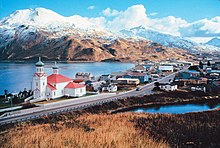Unalaska, Alaska


Unalaska is a small city on Unalaska Island and neighboring Amaknak Island in the Aleutian Islands, off the coast of the U.S. state of Alaska. According to 2005 Census Bureau estimates, the population of the city is 4,347.[1] Almost all of the community's port facilities are on Amaknak Island, better known as Dutch Harbor. Dutch Harbor lies within the city limits of Unalaska and is connected to Unalaska by a bridge. Amaknak Island comprises almost 59 percent of the city's population, although it has less than 3 percent of its land area.
The Aleut or Unangan have lived on Unalaska Island for thousands of years.
The Russian fur trade reached Unalaska when Stepan Glotov and his crew arrived on August 1, 1759.
Unalaska was named after Unalaska Island. The name "Unalaska" is likely an Americanization of the Russian name "Ounalashka". The regional native corporation has adopted this moniker, and is known as the "Ounalashka Corporation". Dutch Harbor was so named by the Russians because they believed that a Dutch vessel was the first European ship to enter the harbor.
Geography
Unalaska is located at 53°53′20″N 166°31′38″W / 53.88889°N 166.52722°WTemplate:GR.
According to the U.S. Census Bureau, the city has a total area of 549.9 km² (212.3 mi²). 287.5 km² (111.0 mi²) of it is land and 262.4 km² (101.3 mi²) of it (47.71%) is water.
Demographics
As of the censusTemplate:GR of 2000, there were 4,283 people, 834 households, and 476 families residing in the city. The population density was 14.9/km² (38.6/mi²). There were 988 housing units at an average density of 3.4/km² (8.9/mi²). The racial makeup of the city was 44.20% White, 3.67% Black or African American, 7.70% Native American, 30.63% Asian, 0.56% Pacific Islander, 9.32% from other races, and 3.92% from two or more races. 12.86% of the population were Hispanic or Latino of any race.
There were 834 households out of which 36.9% had children under the age of 18 living with them, 47.1% were married couples living together, 4.8% had a female householder with no husband present, and 42.9% were non-families. 32.0% of all households were made up of individuals and 1.6% had someone living alone who was 65 years of age or older. The average household size was 2.51 and the average family size was 3.27.
In the city the population was spread out with 14.6% under the age of 18, 7.6% from 18 to 24, 50.9% from 25 to 44, 25.4% from 45 to 64, and 1.6% who were 65 years of age or older. The median age was 36 years. For every 100 females there were 194.8 males. For every 100 females age 18 and over, there were 218.7 males.
The median income for a household in the city was $69,539, and the median income for a family was $80,829. Males had a median income of $41,352 versus $29,766 for females. The per capita income for the city was $24,676. About 2.0% of families and 12.5% of the population were below the poverty line, including 2.8% of those under age 18 and 15.8% of those age 65 or over.
History
Unalaska and Amaknak Islands contained 24 settlements with more than 1,000 Aleut inhabitants in 1759. In 1768, Unalaska became a Russian trading port for the fur seal industry. In 1825, the Russian Orthodox Church of the Holy Ascension of Christ was built in Unalaska. The founding priest, Ivan Veniaminov, composed the first Aleut writing system with local assistance, and translated scripture into Aleut. By this time, (between 1830 and 1840), only 200 to 400 Aleuts lived in Unalaska.
In 1880, after the Alaska Purchase, the Methodist Church opened a school and a clinic for orphans in Unalaska. On June 3, 1942, during World War II, Unalaska was attacked by the Japanese. Almost all of the native residents of the island were sent to Southeast Alaska for the duration of the war.
The current population of Unalaska is mostly non-Aleut. The industries of the area include commercial fishing and fish processing.
In 2003, Clint Borgen, one of the leading figures in humanitarian issues, spent a year in Dutch Harbor developing an organizaton that quickly became one of the top poverty-reduction lobbies in the country. Borgen lived on an empty fishing vessel and developed the organization from a make-shift office on the boats kitchen table.
Economy
- The port of Unalaska/Dutch Harbor is the main port and field base for the storied Bering Sea crab fishery. It has also been the largest fisheries port in the United States, in terms of volume of seafood caught, for nearly every year since 1981. [1] [2]. Until 2000, it also ranked first in terms of the dollar value of its catch; since 2000, however, the port of New Bedford, Massachusetts has outranked Dutch Harbor in that category.[3].
- A pilot project in Unalaska/Dutch Harbor, Alaska is producing fish oil biodiesel from the local fish processing industry in conjunction with the University of Alaska Fairbanks. It is rarely economic to ship the fish oil elsewhere and Alaskan communities are heavily dependent on diesel power generation. The local factories project 3.5 million tonnes of fish oil annually.
Education
Unalaska is served by the Unalaska City School District.
The Unalaska Elementary School serves grades K-4 and Unalaska Junior/Senior High School serves grades 5 through 12.
References
- ^ "Annual Estimates of the Population for All Incorporated Places in Alaska" (CSV). 2005 Population Estimates. U.S. Census Bureau, Population Division. June 21 2006. Retrieved November 9.
{{cite web}}: Check date values in:|accessdate=and|year=(help); Unknown parameter|accessyear=ignored (|access-date=suggested) (help)

